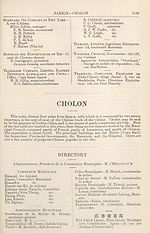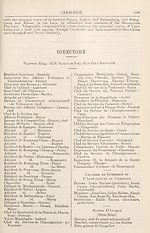1917
(1297) [Page 1184] - Cambodge
Download files
Complete book:
Individual page:
Thumbnail gallery: Grid view | List view
![(1297) [Page 1184] - Cambodge](https://deriv.nls.uk/dcn17/1945/4917/194549171.17.jpg)
CAMBODGrE
Cambodia, the kingdom of the Khmer, extends from J01 deg. 30 min. to 104*
deg. 30 min. longitude E. of Paris, and from 10 deg. 30 min. to 14 deg. latitude.
It was reduced -to its present proportions in 186‘u by the annexation of its two-
richest provinces, Angkor and Battambang, to Siam. Its area is about 62,000 square
miles. It is bounded on the south-west by the Gulf of Siam, on the south-east by French
-Cochin-China, on the north by the French Laos, and on the north-west and west
by Angkor and Battambang. The noble river Mekong flows through the kingdom,,
and after passing through French Cochin-China, empties itself, by a number
of mouths, into the sea. The Mekong is the grand waterway of Cambodia, and,
like the Nile in Egypt, lays the greater part of the country under water annually,
greatly increasing its fertility. The soil of Cambodia is rich and productive, and rice,
pepper, indigo, cotton, tobacco, sugar, maize and cardamoms are cultivated. Coffee
and spices of all sorts could be grown. Among woods ebony, rose, sapan, pine,
and other valuable sorts exist, no less than eighty different kinds of timber being found
in the forests. Iron of good quality has been discovered, and it is affirmed that there
are gold, silver, and lead mines in the mountains. The fisheries of Cambodia are very
productive, and salt fish forms one of the chief articles of export. Large quantities
of fish oil are also produced.
Cambodia was once an extensive and powerful State, and proofs that it possessed a
much higher civilisation than that which now prevails in the country are to be
found in the architectural remnants of former grandeur. The noble ruins of the
ancient city of Angkor are monuments of a people much superior to the feeble race
which now inhabits Cambodia. The Cambodians differ entirely from their neighbours,
the Annamites, both in features and customs. Polygamy is practised among them.
The prevailing religion is Buddhism. The people are apathetic and indolent, and
have allowed the trade to fall into the hands of Chinese, of whom there are about
160,000 in the country. The entire population of the kingdom is about 1,000,000;
Slavery, since its abolition by the French Treaty of 1884, has almost entirely
disappeared.
The Government of Cambodia is a monarchy under French protection. The
present King, Sissowath, succeeded his brother, King Norodom. In June, 1884,
Norodom signed a new Treaty -with France, by which the administration of
the country was handed over to French Besidents. Since the Convention of 1892
the native functionaries are appointed by the King, under the control of the French-
Administration, and are paid from the treasury of this kingdom.
Phnom-penh, the present capital of Cambodia and seat of the Government, is-
situated on the river Mekong, nearly in the heart of the kingdom. The king’s palace
is a large building, and the portion devoted to his use is built and furnished in European-
style. French functionaries have charge of the Treasury, the administration of justice,
customs, and public works and taxes. Phnom-penh has been considerably improved
under the present rule, especially since the year 1889. Many roads have been made
and numerous sanitary works carried out in the town, such as drainage works,
the filling up of pools, marshes, etc. The town has also been provided with
waterworks and electric light. The new Treasury, in the ancient Khmer style of
architecture, is a most remarkable building. The other prominent public buildings
are the Post Office, Court, Hospital, Personnel and Registration Office, Commissariat
of Police, new barracks for Marine Infantry, Public Works Office, Commercial Museum,
Harbour Office, and the Indo-China Bank and Messageries Fluviales agencies. The
Resident Superieur has a handsome residence in the city. The population of Phnom -
penh is estimated at 39,000. Though the country generally is entirely undeveloped
trade at present is considerably extending. Cambodia has no seaports of any impor¬
tance, and the import and export trade passes through the port of Saigon. Customs
dues have been imposed since July, 1887, with exemptions in favour of French
goods and shipping. The tariff is based on the general tariff of France, modified
in certain points. The port of Kampot can only be frequented by small native
coasting vessels from Siam and by Chinese junks. Easy communication is afforded
Cambodia, the kingdom of the Khmer, extends from J01 deg. 30 min. to 104*
deg. 30 min. longitude E. of Paris, and from 10 deg. 30 min. to 14 deg. latitude.
It was reduced -to its present proportions in 186‘u by the annexation of its two-
richest provinces, Angkor and Battambang, to Siam. Its area is about 62,000 square
miles. It is bounded on the south-west by the Gulf of Siam, on the south-east by French
-Cochin-China, on the north by the French Laos, and on the north-west and west
by Angkor and Battambang. The noble river Mekong flows through the kingdom,,
and after passing through French Cochin-China, empties itself, by a number
of mouths, into the sea. The Mekong is the grand waterway of Cambodia, and,
like the Nile in Egypt, lays the greater part of the country under water annually,
greatly increasing its fertility. The soil of Cambodia is rich and productive, and rice,
pepper, indigo, cotton, tobacco, sugar, maize and cardamoms are cultivated. Coffee
and spices of all sorts could be grown. Among woods ebony, rose, sapan, pine,
and other valuable sorts exist, no less than eighty different kinds of timber being found
in the forests. Iron of good quality has been discovered, and it is affirmed that there
are gold, silver, and lead mines in the mountains. The fisheries of Cambodia are very
productive, and salt fish forms one of the chief articles of export. Large quantities
of fish oil are also produced.
Cambodia was once an extensive and powerful State, and proofs that it possessed a
much higher civilisation than that which now prevails in the country are to be
found in the architectural remnants of former grandeur. The noble ruins of the
ancient city of Angkor are monuments of a people much superior to the feeble race
which now inhabits Cambodia. The Cambodians differ entirely from their neighbours,
the Annamites, both in features and customs. Polygamy is practised among them.
The prevailing religion is Buddhism. The people are apathetic and indolent, and
have allowed the trade to fall into the hands of Chinese, of whom there are about
160,000 in the country. The entire population of the kingdom is about 1,000,000;
Slavery, since its abolition by the French Treaty of 1884, has almost entirely
disappeared.
The Government of Cambodia is a monarchy under French protection. The
present King, Sissowath, succeeded his brother, King Norodom. In June, 1884,
Norodom signed a new Treaty -with France, by which the administration of
the country was handed over to French Besidents. Since the Convention of 1892
the native functionaries are appointed by the King, under the control of the French-
Administration, and are paid from the treasury of this kingdom.
Phnom-penh, the present capital of Cambodia and seat of the Government, is-
situated on the river Mekong, nearly in the heart of the kingdom. The king’s palace
is a large building, and the portion devoted to his use is built and furnished in European-
style. French functionaries have charge of the Treasury, the administration of justice,
customs, and public works and taxes. Phnom-penh has been considerably improved
under the present rule, especially since the year 1889. Many roads have been made
and numerous sanitary works carried out in the town, such as drainage works,
the filling up of pools, marshes, etc. The town has also been provided with
waterworks and electric light. The new Treasury, in the ancient Khmer style of
architecture, is a most remarkable building. The other prominent public buildings
are the Post Office, Court, Hospital, Personnel and Registration Office, Commissariat
of Police, new barracks for Marine Infantry, Public Works Office, Commercial Museum,
Harbour Office, and the Indo-China Bank and Messageries Fluviales agencies. The
Resident Superieur has a handsome residence in the city. The population of Phnom -
penh is estimated at 39,000. Though the country generally is entirely undeveloped
trade at present is considerably extending. Cambodia has no seaports of any impor¬
tance, and the import and export trade passes through the port of Saigon. Customs
dues have been imposed since July, 1887, with exemptions in favour of French
goods and shipping. The tariff is based on the general tariff of France, modified
in certain points. The port of Kampot can only be frequented by small native
coasting vessels from Siam and by Chinese junks. Easy communication is afforded
Set display mode to:
![]() Universal Viewer |
Universal Viewer | ![]() Mirador |
Large image | Transcription
Mirador |
Large image | Transcription
Images and transcriptions on this page, including medium image downloads, may be used under the Creative Commons Attribution 4.0 International Licence unless otherwise stated. ![]()
| Asian directories and chronicles > 1917 > (1297) [Page 1184] - Cambodge |
|---|
| Permanent URL | https://digital.nls.uk/194549169 |
|---|
| Attribution and copyright: |
|
|---|---|
| Description | Volumes from the Asian 'Directory and Chronicle' series covering 1917-1941, but missing 1919 and 1923. Compiled annually from a multiplicity of local sources and research. They provide listings of each country's active corporations, foreign residents and government agencies of all nationalities for that year, together with their addresses. Content includes: various treaties; coverage of conflicts; currencies and taxes; consular fees; weights and measures; public holidays; festivals and traditions. A source of information for both Western states and communities of foreigners living in Asia. Published by Hongkong Daily Press. |
|---|---|
| Shelfmark | H3.86.1303 |
| Additional NLS resources: |

